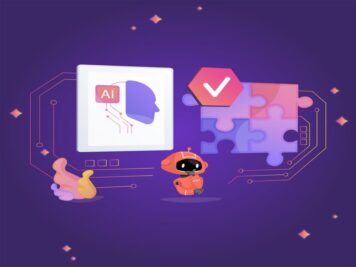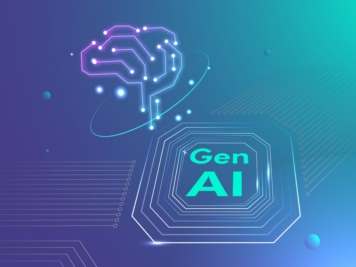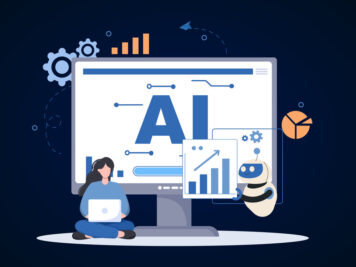Have you noticed how artificial intelligence is changing the way we communicate? It has a big impact on one of our most natural behaviors: conversation! As per GlobeNewswire report, the conversational AI market size is expected to grow from US$ 8.45 billion in 2023 to US$ 39.55 billion by 2031. So, what’s driving this craze for conversational AI use cases?
The answer lies in fundamental changes in customer expectations. We all want tailored and convenient experiences these days, right? Conversational AI solutions such as chatbots and virtual assistants are ideal for achieving this goal. That’s why businesses across all industries are jumping on board to offer 24/7 help, answer our pressing questions, and even personalize our experience.
And the future seems brighter. Gartner predicts that by 2026, 80% of conversational AI products will use GenAI. This means our interactions with virtual assistants will be more natural and engaging than ever before. As AI’s ability to evaluate data and respond quickly becomes a must-have for businesses, more organizations will use conversational AI. This will lead to an increase in new and exciting conversational AI use cases across industries.
In this article, we will cover conversational AI use cases across 5 industries along with its benefits and FAQs.
Understanding Conversational AI
Conversational AI, also called conversational interfaces or chatbots, is a type of artificial intelligence (AI) capable of mimicking human conversation. It uses natural language processing (NLP) to understand and respond to what you say or write, giving the impression that you are talking to another person.
The two faces of conversational AI: chatbots and virtual assistants
Different conversational AI’s work differently! Let’s break down the two main types: chatbots and virtual assistants
Chatbots are like helpful robots that have been programmed with predetermined questions and responses. They are good at answering simple queries and can be a lifesaver for organizations dealing with frequent requests. They can be broken down as:
- Rule-based chatbots: They follow preset scripts and provide pre-written answers based on keywords you provide. Think of them as decision trees that lead you along a predetermined route to a solution. Great for chores like appointment scheduling and password resets.
- AI-driven chatbots: These are more advanced bots that use machine learning to understand your intent and respond appropriately. They are able to handle more difficult queries and even use information gleaned from previous interactions to gradually enhance their responses.
Virtual assistants, on the other hand, are the artificially intelligent friends we know and love. Think back to Google Assistant, Alexa or Siri. In addition to text chat, they can control smart home devices and understand natural language voice commands. Virtual assistants are designed to be your go-to help when you need it, providing customized information and handling household chores based on your requirements.
Let’s now discuss some of the top industry conversational AI use cases.
Conversational AI use cases in healthcare
Advancements in robotics and AI are reshaping healthcare. Conversational AI solutions have notably improved interactions among patients, doctors, and hospital staff. Its impact, especially during the pandemic, has led to a significant increase in adoption.
Here are some of the important conversational AI use cases in healthcare:-
Public health information dissemination
Rapidly spreading false or misleading information during public health emergencies can make people panic. This we all experienced when the Covid was at its peak. Healthcare organizations countered the issues by deploying AI Chatbots. WHO used an interactive chatbot to send accurate information about the virus to people in multiple languages directly on their mobile phones.
The bots have evolved since then. They can now help raise awareness across digital platforms, like social media, websites, messaging apps, etc. Such conversational AI tools disseminate correct and relevant information and answer all the questions people have. These AI chatbots are trained on real datasets to ensure that they pass relevant information to users.
But chatbot’s don’t come up with the answers of their own; they scan through large amount of data to find the correct response. For that, proper training and testing are important to ensure that responses from these AI bots are not biased.
To minimize bias in those replies, businesses must ensure that their bots have been trained on the right and comprehensive data.

Appointment scheduling
Scheduling appointments with doctors using traditional methods like phone calls and emails is often time-consuming. With conversational AI, the process can be made simpler. AI-powered chatbots can act as a medium to check and verify availability. Based on that patients can book, reschedule, or cancel appointments with the doctors at any time.
When it comes to doctors and hospital staff, they can confirm the appointment using a text message or a voice command using chatbots. These chatbots with Natural Language Processing (NLP) are highly accurate, which eliminates the risk of double bookings.
Healthcare staff can also use conversational AI apps for appointment reminders and sharing valuable information, such as required medical reports for assessments.
Patient support
Patients are not always tech-savvy. A lot of them see digital platforms as a barrier to accessing their health data. They find processes like account creation or a new password setting cumbersome. Conversational AI can remove the obstacle and promote ownership and trust in the healthcare system.
It can guide these people by breaking down the process as per their requirements and help them with their queries.
AI assistants can also help automate responses to certain FAQs and resolve specific queries. Cardinal Health, a global healthcare service company, has recently started using an AI-powered virtual Assistant, CHIA. This AI Assistant helps patients by answering queries about medical products and medicine shipments, improving their overall user experience.
Improved decision-making for healthcare professionals
To accelerate conversational AI in healthcare, researchers are creating state-of-the-art technologies such as generative pre-trained Transformers with recurrent neural networks (GPbRNN). Imagine being in a conversational session where an AI assistant not only accurately answers your questions, but also detects your mood indicators.
So if you feel overwhelmed by a new diagnosis, the GPbRNN chatbot will recognize it. It can then change its communication style to be more compassionate and offer more resources or help with alternatives. This tailored approach can significantly improve the patient’s experience.
Additionally, GPbRNN is always learning and improving. They can improve their ability to predict and respond to patient needs by analyzing large amounts of medical data and real-time interactions. It’s like having a very smart and helpful partner on your health journey!
Conversational AI use cases in fintech
In the fintech space, conversational AI has emerged as a major game-changer. People generally perceive banking as a complicated process. But AI bots are now making it more engaging by enabling round-the-clock customer service and increasing the number of conversational AI use cases in fintech.
Fraud detection
Loss in the fintech industry due to fraud is huge. PYMNTS and Ingo Money conducted research to find the average amount of loss in the US alone is close to $51 million per year. But the recent developments in AI-powered fintech chatbots for real-time monitoring and multi-factor authentication to detect fraudulent activities are showing promising signs.
AI chatbots now use NLP to easily find out irregularities in users’ chatting patterns. Once detected, they quickly block or flag such unusual transactions.
Personal banking assistants
Voice assistants and AI chatbots have become essential in handling and answering basic queries. Its credit goes to the Dutch bank ING for revolutionizing the segment by launching Inge, the first voice assistant in banking, in 2014.
Since then, the bank-customer dynamics has transformed. Customers now interact with similar chatbots in natural language, asking them questions like “What is the status of my loan application?”, “Can you show my past five transactions?” “How long does it take to process a home loan?”, etc. In 2024, 82 percent of consumers stated that they would use a chatbot instead of waiting for a customer representative to take their call.
But these AI bots don’t just give answers for basic queries. They can handle more complex problems as well. They can offer customers personalized financial advice or investment decisions by processing data and analyzing their accounting activities. Also, these tools can help set reminders for bill payments to avoid any overdue or additional charges.
Collect feedback
Industries are now more customer-driven. It forces businesses to value customer feedback for insights that can shape strategic decisions. They have started using feedback bot to collect feedback to identify the user’s mood using NLP and respond to conversations accordingly.
Interaction with customer care, ATM issues, payment difficulties, etc., are some other modes using which customers can submit their feedback. It helps banks to analyze and improve customer experience and understand areas of improvement.
Conversational AI use cases in real estate
When it comes to data about properties, communities, tenants, economic fluctuations, geopolitical issues, and the market, real estate investors have decades of experience. Modeling a conversational AI bot based on this information can be a good starting point. It can help real estate companies improve the productivity of their real estate agents, closing deals faster, and, most importantly, increasing sales.
Exploring conversational AI use cases in AI can provide a more in-depth understanding of the scenario.
Lead capturing and management
Getting a lead is crucial for any business, but if it doesn’t convert, that lead becomes a zero lead. Conversational AI can be the first point of contact for collecting leads. By initiating a conversation, it can collect valuable information from the prospect. This information can be personal (name, budget, contact details, etc.) or about the prospect’s purpose (buying, selling, or renting).
With such information, companies can quickly create categories like warm, hot, promising, etc. They can use a database management system to store the collected information. Agents or retailers can then access this information to contact high-quality leads. These steps can streamline the entire process and make it more productive and less time-consuming.
Personalized property suggestions
Buying a home is a drawn-out task, dependent on the buyers’ tastes, which vary from one buyer to another. This variation creates the need for personalized solutions. For such offers, creating personalized customer profiles based on their unique needs is crucial. Chatbot’s ability to collect information about preferences, preferred area, property type, budget, etc., can come in handy for investors.
With the information, the chatbot can create individual profiles and offer personalized property suggestions. If the visitor expresses interest in a property, the chatbot can use an advanced algorithm to scan the extensive listings, identifying those matching the customer’s criteria. It can then present a list of curated options, increasing the chances of successful conversion.
Also Read: How we helped our client build feature-rich products that simplify complex investment decisions using various AI models. Read full case study!
Scheduling property visits
Scheduling property visits is like test-driving a car before buying it. It gives buyers a chance to feel the vibes of the place, explore every detail, and envision themselves living there. It’s the real-life experience that can make or break a deal.
By using conversational AI, real estate agents can automate the scheduling, facilitating buyers to book appointments at their convenience without the back-and-forth hassles. Chatbots can ask visitors about their preferred timeslot and date, and check availability in the agent’s calendar to schedule a visit.
Once a suitable timeslot is found, chatbots can send reminders to both parties before the scheduled date. This automated process makes communication more efficient and helps save time for both parties.
Conversational AI use cases in retail
Customers’ buying experiences and their behavior around how they should engage with businesses have changed over the past few years. These days, it makes more sense to bring a store to the customers where they are. Brands who are switching to conversational AI are reaping benefits of more sales and customer base.
Delving into conversational AI use cases in retail can provide more clarity about the dynamic shifts.
Improving in-store experience
With Amazon, Walmart and others all spending big to make in-store experience outstanding, one thing is clear, conversational AI is set to experience a seismic shift in its uptake. Its ability to make the in-store experience for shoppers more enjoyable, engaging, interactive, and efficient is the main catalyst. By deploying AI chatbots in retail stores, retailers can offer customers more personalized assistance and real-time product recommendations.
Customers can ask an AI-powered bot or virtual assistant for details about specific items, their availability, or assistance in finding the right size when they visit the shop. Virtual assistants, on the other hand, will provide accurate information, helping shoppers save time and improve their overall experience.
Order tracking
Customers prefer to receive their orders on time, and if they get them earlier, even better. That’s why they keep tracking the order status with retailers. With voice assistants, messaging bots, or AI chatbots, online retailers and ecommerce platforms can make the process more efficient and convenient.
Conversational AI solutions use NLP and ML technologies to provide customers with real-time order updates. This can also increase operational efficiency for retailers by reducing the need for manual tracking and customer support.
Better decision making
Real-time analysis of user behavior and other data can help retailers make better decisions. Conversational AI, capable of understanding natural language, makes deploying AI chatbots a great move. They engage with customers, understand their intent, and gather feedback and other relevant details for improved decision-making.
AI Chatbots can continuously learn and adapt to changing customer needs and preferences due to their inbuilt ML algorithms. When leveraged properly, retailers can engage more customers by catering to their specific needs and stay ahead in the market.
Conversational AI use cases in recruitment
Recruitment teams face intense pressure during talent shortages when the expectation is to find candidates swiftly. If the position is niche, locating the best candidate can turn into a nightmare. Conversational AI can ease this pressure for the HR professionals.
Here are some of the prominent conversational AI use cases in recruitment: –
Candidate screening
Scanning through hundreds of applications to find the most suitable candidate can pile pressure on resources. AI based chatbot has already started to simplify the entire screening process by communicating with candidates like human to get basic information.
To check a candidate’s value for the position, AI bots generally ask about qualifications, interests, skills etc. Based on the answers they filter the candidate for the next step. This automated screening helps save time for both parties and keep the candidates engaged.
Scheduling interviews
The most frustrating part of the recruitment process is scheduling interviews. Setting up the interviews of multiple candidates with interviewers sometimes becomes very tedious as it involves chasing down interviewers and candidates to find a common time to set up the interview.
Conversational AI can speed up the hiring process by scheduling interviews based on the availability of both parties, eliminating the need for manual coordination. AI-powered chatbots can help smooth the recruiting process, helping hiring managers focus on other essential tasks.
Chatbots can also send reminders to recruiters and candidates and minimize the possibility of cancellations or no-shows.
Onboarding
When a candidate is hired, recruitment teams gather certain information like payroll, various benefits and other administrative work. This process can be streamlined with conversational AI. The tool can do labor-intensive work to make onboarding easier and faster and free up time for the team.
Conversational AI can also provide a personalized experience for new hires by answering their queries and delivering the information they seek. These bots can guide new hires through company pages and engage them with training modules, ensuring candidates feel connected from day one.
Benefits of Conversational AI
Conversational AI has become a must-have for businesses across various industries. Implementing it smartly can help companies to stay competitive and meet customer demands more effectively. Checking the key benefits of conversational AI can be a starting point.
Boost productivity and save cost
One of the primary benefits of using conversational AI solutions is automation. Conversational AI, when integrated into any website or social media platform, can handle all laborious tasks, allowing employees to focus on complex tasks. This can boost staff productivity and efficiency, resulting in cost savings for the company.
Availability
Conversational AI solutions can work round the clock to offer clients quick responses and assistance.
AI-powered chatbots can manage and handle several interactions simultaneously, ensuring every client receives the attention they deserve without sacrificing response times. This availability feature helps businesses expand and cater to a growing consumer base.
Scalability
As per business needs, conversational AI can scale easily as it can handle multiple customers simultaneously. It is beneficial when a product/service expands to new geographical markets or when website traffic rises during the sales season.
This scalability feature helps the firm to provide excellent customer service even during peak periods, increasing customer satisfaction and sales.
Personalization
Conversational AI can analyze and provide individualized product suggestions based on the user preferences, browsing behavior and purchase history. Businesses can use conversational AI solutions to improve cross-selling and up selling opportunities by analyzing the unique requirements and preferences of each customer, eventually driving revenue.
Conversational Al case studies
Case Study : Improving Product Adoption using Conversational AI.
We were approached by a marketing tech company in Palo Alto, California, with a challenge: they had built an AI-powered product to help businesses engage with customers on social media platforms, but they weren’t sure how to achieve product-market fit. Their initial solution, a messenger bot, helped them engage with customers at scale, but it lacked personalization.
To address this, we implemented Machine Learning solutions that allowed us to deliver tailored messaging that resonated with individual customers. This could include things like using a customer’s name, referencing their past purchases, or recommending products based on their interests. As their audience grew, manual comment moderation became a hurdle. We integrated NLP solutions for automatic content flagging, freeing up their team for strategic tasks.
By taking a data-driven, scalable approach to conversational AI, we were able to help our client achieve significant results. They achieved product-market fit, secured seed round funding, and were ultimately acquired by another company.
Case Study : Achieving Product-Market-Fit the Lean Way
Another client, a recruitment software company, wanted to improve the user experience for hiring managers and interviewers. They had a chatbot interface, but it relied on pre-defined templates that felt clunky and limited. Users found it frustrating to keep returning to the main menu for each new question.
We knew conversational AI could be the answer. We used an open-source platform that allowed for customization and built a chatbot that could understand natural language. The key was training the AI with the right data – we created flexible templates based on the specific language used in the recruitment world. We also fine-tuned the AI’s algorithms to accurately understand the intent behind user questions, whether they were hiring managers, interviewers, or even employees submitting referrals.
That’s just a taste of what conversational AI can do! Businesses across industries are using this technology to deliver incredible user experiences on a regular basis. It’s akin to having a hidden weapon to overcome obstacles and improve conditions for everyone. Isn’t it cool? There is no doubt that Conversational AI is changing the game, and we are here to support you in leveraging Conversational AI to undoubtedly change the game!

Bottom Line
Conversational AI is changing how industries work, and its impact is only going to rise with generative AI. When used together, conversational AI and generative AI can make chatbots that feel human-like, personalized, and intelligent.
Drawing on our 20+ years of experience and a track record of engineering 180+ tech products, we are here to lend our expertise. Our AI development teams have AI, data science, development, UI/UX, and DevOps experts. They have successfully delivered over 30+ AI-powered solutions. Check out our AI development services to see how we can assist you!









